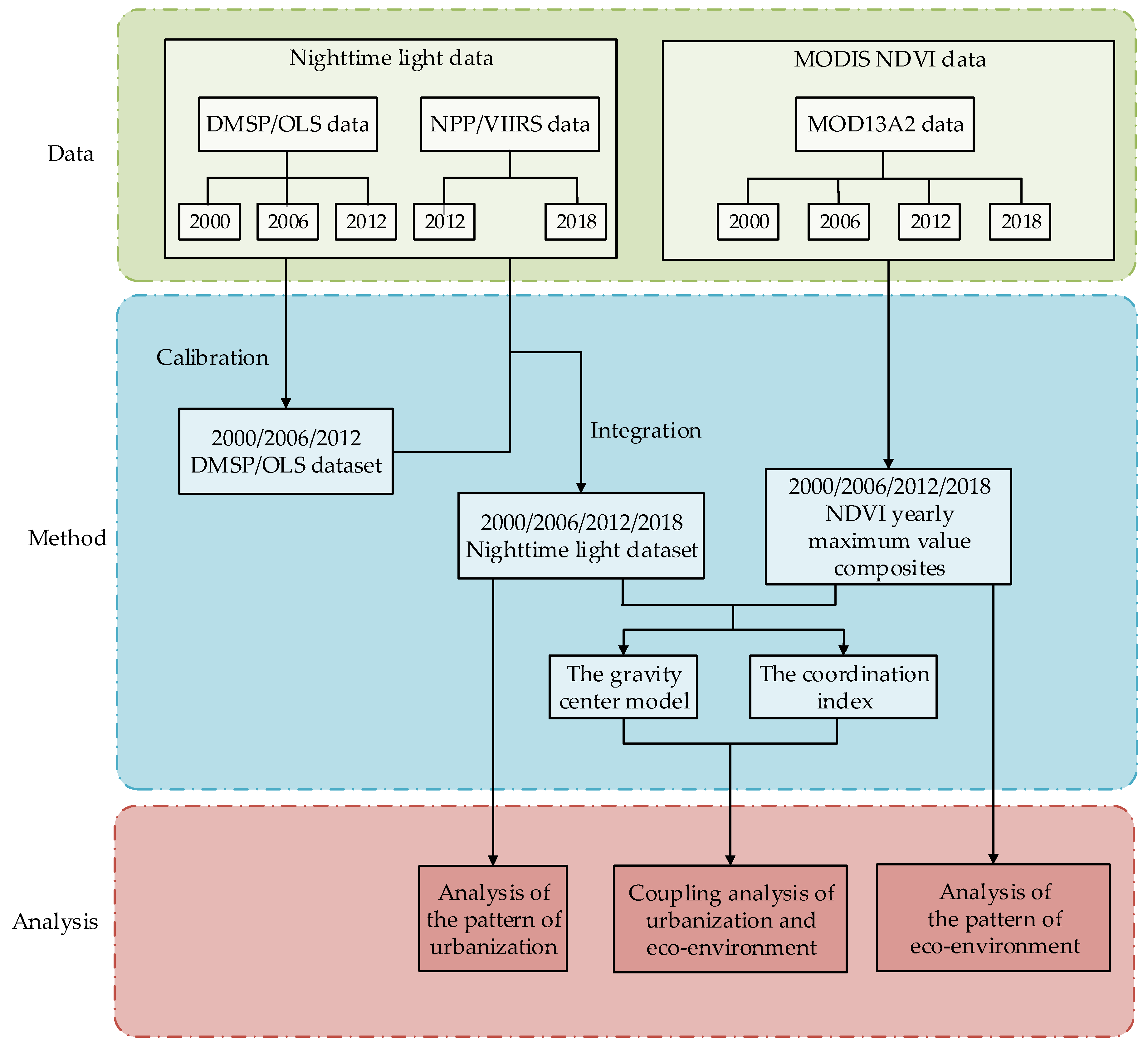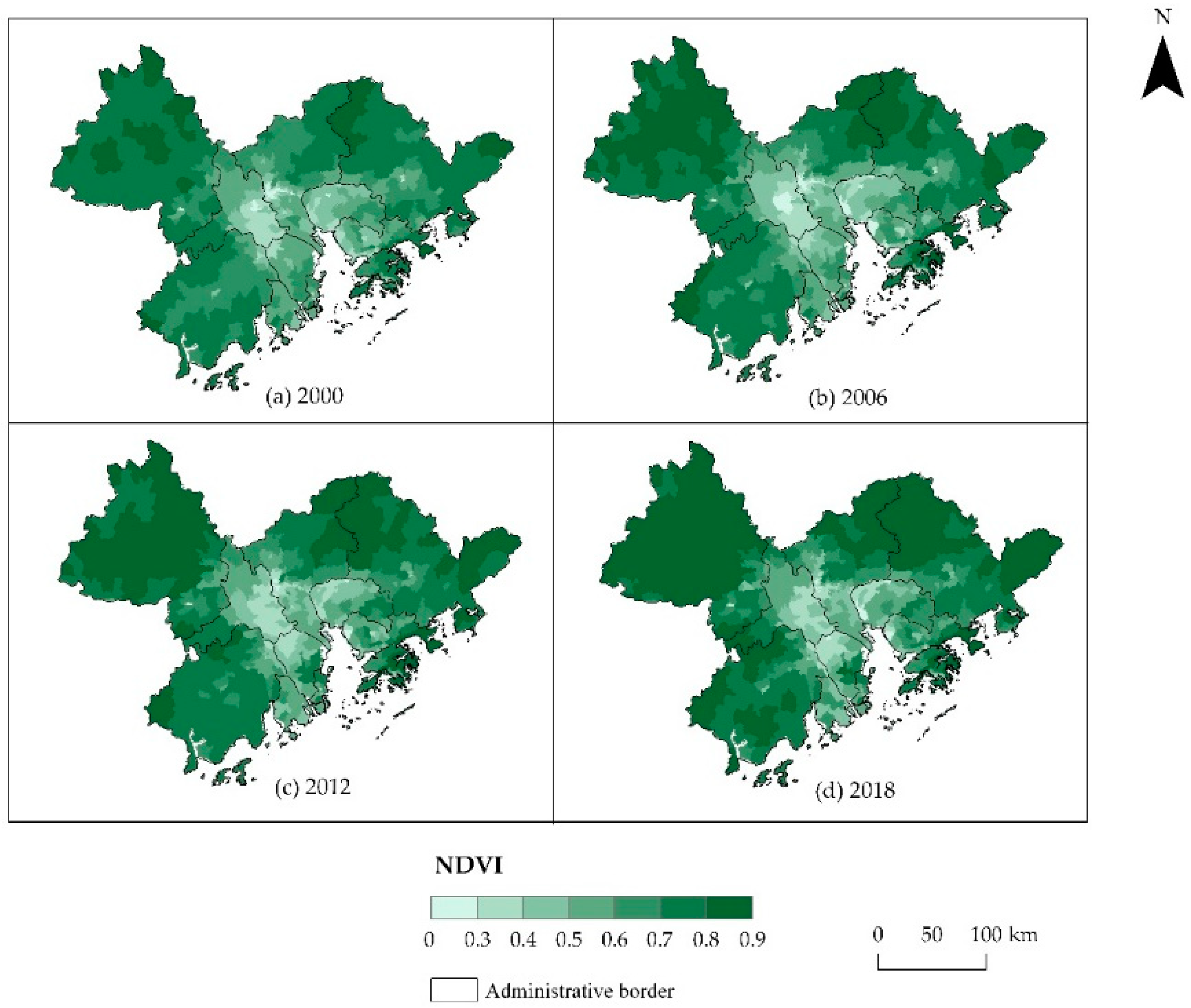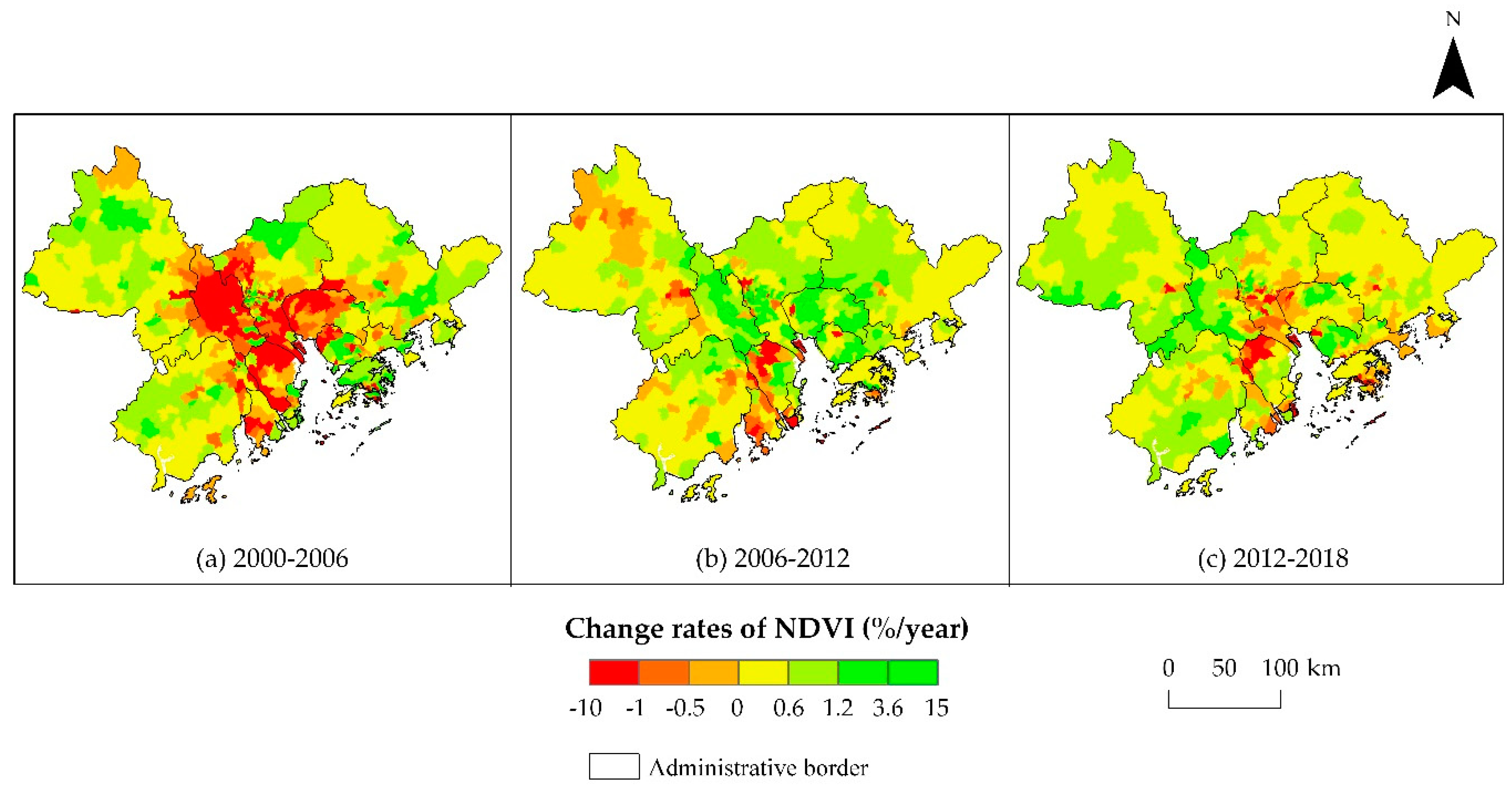Using Remote Sensing Data to Study the Coupling Relationship between Urbanization and Eco-Environment Change: A Case Study in the Guangdong-Hong Kong-Macao Greater Bay Area
Abstract
:1. Introduction
2. Study Area and Data
2.1. Study Area
2.2. Data Sources and Pre-Processing
2.2.1. Nighttime Light Data
2.2.2. MODIS NDVI Data
3. Methods
3.1. Evaluation Indices of Urbanization and the Eco-Environment
3.2. Calibration and Integration of Nighttime Light Data
3.2.1. Calibration of DMSP/OLS Data
3.2.2. Integration of Nighttime Light Data
- (1)
- For each DN value, all pixels in the DMSP/OLS image from 2012 and the corresponding pixels in the NPP/VIIRS image for the same year were extracted. Then, the average radiation value of the extracted NPP/VIIRS pixels was calculated (Table S1, Supplementary Material), and a scatterplot was generated with the average radiation value of NPP/VIIRS data as the independent variable (the unit is nW/cm2/s) and the DN value of DMSP/OLS data as the dependent variable. We selected the pixels whose DN value was equal to or less than 50 to reduce the influence of pixel saturation [37]. The fitted curve for 2012 is shown in Figure 3. The integration function is given in Formula (5):where radiance represents the radiation value of the NPP/VIIRS data, and DN represents the DN value simulated from the NPP/VIIRS data.DN = 15.519506 × radiance0.5510601,
- (2)
- Formula (5) was used to simulate DMSP/OLS data for 2018. Then a Gaussian low-pass filter with a window size of 3 pixels was used to smooth the simulated image.
- (3)
- Finally, the continuity calibration was performed again using Formula (4) to ensure the continuity of the whole dataset.
3.3. The Gravity Center Model
3.3.1. Overlapping of Gravity Centers
3.3.2. The Consistency of Movements
3.4. The Coordination Index
4. Results and Discussion
4.1. Analysis of the Pattern of Urbanization
4.1.1. A Circular Structure
4.1.2. Rise in Urban Border Areas
4.2. Analysis of the Pattern of Eco-Environment
4.3. Coupling Analysis of Urbanization and Eco-Environment Change
4.3.1. Overall Coupling Situation
4.3.2. Spatial Differentiation Characteristics of Coupling
5. Conclusions
Supplementary Materials
Author Contributions
Funding
Acknowledgments
Conflicts of Interest
References
- Morgan Stanley. The Rise of China’s Supercities: New Era of Urbanization. Available online: https://www.morganstanley.com/ (accessed on 10 October 2019).
- Li, Y.F.; Li, Y.; Zhou, Y.; Shi, Y.L.; Zhu, X.D. Investigation of a coupling model of coordination between urbanization and the environment. J. Environ. Manag. 2012, 98, 127–133. [Google Scholar] [CrossRef] [PubMed]
- Liu, Y.B.; Li, R.D.; Song, X.F. Analysis of Coupling Degrees of Urbanization and Ecological Environment in China. J. Nat. Res. 2005, 20, 105–112. [Google Scholar]
- Qiao, B.; Fang, C.L. The dynamic coupling model of the harmonious development between urbanization and its application in arid area. Acta Ecol. Sin. 2005, 25, 211–217. [Google Scholar]
- Fang, C.L. Dissipative Structure Theory and Geography system. Arid Land Geogr. 1989, 12, 53–58. [Google Scholar]
- Fang, C.L.; Yang, Y.M. Basic laws of the interactive coupling system of urbanization and ecological environment. Arid Land Geogr. 2006, 29, 1–8. [Google Scholar]
- Hu, Y.Y.; Cao, W.D. Study on the evolution of urbanization coordination in China during recent thirty years. City Plan. Rev. 2016, 40, 9–17. [Google Scholar]
- Zhang, Y.; Cao, W.D.; Liang, S.B.; Li, Y.Y. A Comparative Study on the Evolution Process of Urbanization and Industrialization in the Underdeveloped Areas of Western China: A Case Study of Qinghai Province. Econ. Geogr. 2017, 37, 61–67. [Google Scholar]
- Fan, J.; Tao, A.J.; Lv, C. The Coupling Mechanism of the Centroids of Economic Gravity and Population Gravity and Its Effect on the Regional Gap in China. Prog. Geogr. 2010, 29, 87–95. [Google Scholar]
- Yang, Z.W.; Chen, Y.B.; Wu, Z.F.; Zheng, Z.H. The coupling between construction land expansion and urban heat island expansion in Guangdong- Hong Kong- Macao Greater Bay. J. Geo-Inf. Sci. 2018, 20, 1592–1603. [Google Scholar]
- Zhou, C.S.; Luo, L.J.; Shi, C.Y.; Wang, J.H. Spatio-temporal evolutionary characteristics of the economic development in the Guangdong-Hong Kong-Macao Greater Bay area and its influencing factors. Trop. Geogr. 2017, 37, 802–813. [Google Scholar]
- Zhou, C.S.; Deng, H.H.; Shi, C.Y. A study on synergic development of Guangdong-Hong Kong-Macau Greater Bay area. Planners 2018, 34, 5–12. [Google Scholar]
- Zhou, C.S.; Wang, Y.Q.; Xu, Q.Y.; Li, S.J. The new process of urbanization in the Pearl River Delta. Geogr. Res. 2019, 38, 45–63. [Google Scholar]
- Chen, Z.M. Empirical Analysis of Port Group Positioning in the Guangdong-Hong Kong-Macau Big Bay Area. J. Shenzhen Univ. Humanit. Soc. Sci. 2016, 33, 32–35, 41. [Google Scholar]
- Mao, Y.H.; Rong, J.X. Strategic Positioning and Collaborative Development of Guangdong-Hongkong-Macao Greater Bay Area. J. South China Norm. Univ. Soc. Sci. Ed. 2018, 4, 104–109, 191. [Google Scholar]
- Cai, C.M. The Building of a World-Class City Cluster in Guangdong-Hong Kong-Macao Greater Bay Area: Strategic Meanings and Challenges. Soc. Sci. Guangdong 2017, 4, 5–14, 254. [Google Scholar]
- Peng, F.M. Economic Spatial Connection and Spatial Structure of Guangdong-Hong Kong-Macao Greater Bay and the Surrounding Area Cities—An Empirical Analysis Based on Improved Gravity Model and Social Network Analysis. Econ. Geogr. 2017, 37, 57–64. [Google Scholar]
- Huang, X.H.; Zou, K.M. A Study of the Integration Development of Culture, Commerce and Tourism under the background of “the Belt and Road” Strategy in Guangdong-Hong Kong-Macao Big Bay Area. J. South China Norm. Univ. Soc. Sci. Ed. 2016, 4, 106–110, 192. [Google Scholar]
- Xiang, X.M.; Yang, J. The Paths of the Industrial Synergy Development in Guangdong-Hong Kong-Macao Bay Area. J. South China Norm. Univ. Soc. Sci. Ed. 2017, 2, 17–20. [Google Scholar]
- Lo, C.P. Urban indicators of china from radiance-calibrated digital DMSP/OLS nighttime images. Ann. Assoc. Am. Geogr. 2002, 92, 225–240. [Google Scholar] [CrossRef]
- Ma, T.; Zhou, C.; Pei, T.; Haynie, S.; Fan, J. Quantitative estimation of urbanization dynamics using time series of DMSP/OLS nighttime light data: A comparative case study from China’s cities. Remote Sens. Environ. 2012, 124, 99–107. [Google Scholar] [CrossRef]
- Zhuo, L.; Shi, P.J.; Chen, J.; Ichinose, T. Application of Compound Night Light Index Derived from DMSP/OLS Data to Urbanization Analysis in China in the 1990s. Acta Geogr. Sin. 2003, 58, 893–902. [Google Scholar]
- Elvidge, C.D.; Sutton, P.C.; Ghosh, T.; Tuttle, B.T.; Baugh, K.E.; Bhaduri, B.; Bright, E. A global poverty map derived from satellite data. Comput. Geosci. 2009, 35, 1652–1660. [Google Scholar] [CrossRef]
- Wang, W.; Cheng, H.; Zhang, L. Poverty assessment using DMSP/OLS night-time light satellite imagery at a provincial scale in China. Adv. Space Res. 2012, 49, 1253–1264. [Google Scholar] [CrossRef]
- Wu, J.S.; He, S.B.; Peng, J.; Li, W.F.; Zhong, X.H. Intercalibration of DMSP-OLS night-time light data by the invariant region method. Int. J. Remote Sens. 2013, 34, 7356–7368. [Google Scholar] [CrossRef]
- Amaral, S.; Monteiro, A.M.; Câmara, G.; Quintanilha, J.A. DMSP/OLS night-time light imagery for urban population estimates in the Brazilian Amazon. Int. J. Remote Sens. 2016, 27, 855–870. [Google Scholar] [CrossRef]
- Doll, C.N.H.; Pachauri, S. Estimating rural populations without access to electricity in developing countries through night-time light satellite imagery. Energy Policy 2010, 38, 5661–5670. [Google Scholar] [CrossRef]
- Lo, C.P. Modeling the population of China using DMSP operational linescan system nighttime data. Photogramm. Eng. Remote Sens. 2001, 67, 1037–1047. [Google Scholar]
- Zhuo, L.; Chen, J.; Shi, P.J.; Gu, Z.H.; Fan, Y.D.; Ichinose, T. Modelling Population Density of China in 1998 Based on DMSP/OLS Nighttime Light Image. Acta Geogr. Sin. 2005, 60, 266–276. [Google Scholar]
- Cao, X.; Wang, J.M.; Chen, J.; Shi, F. Spatialization of electricity consumption of China using saturation-corrected DMSP-OLS data. Int. J. Appl. Earth Obs. Geoinf. 2014, 28, 193–200. [Google Scholar] [CrossRef]
- Elvidge, C.D.; Ziskin, D.; Baugh, K.E.; Tuttle, B.T.; Ghosh, T.; Pack, D.W.; Zhizhin, M. A fifteen year record of global natural gas flaring derived from satellite data. Energies 2009, 2, 595–622. [Google Scholar] [CrossRef]
- He, C.Y.; Ma, Q.; Li, T.; Yang, Y.; Liu, Z.F. Spatiotemporal dynamics of electric power consumption in Chinese Mainland from 1995 to 2008 modeled using DMSP/OLS stable nighttime lights data. J. Geogr. Sci. 2012, 22, 125–136. [Google Scholar] [CrossRef]
- Su, Y.X.; Chen, X.Z.; Li, Y.; Liao, J.S.; Ye, Y.Y.; Zhang, H.O.; Huang, N.S.; Kuang, Y.Q. China’s 19-year city-level carbon emissions of energy consumptions, driving forces and regionalized mitigation guidelines. Renew. Sustain. Energy Rev. 2014, 35, 231–243. [Google Scholar] [CrossRef]
- Townsend, A.C.; Bruce, D.A. The use of night-time lights satellite imagery as a measure of Australia’s regional electricity consumption and population distribution. Int. J. Remote Sens. 2010, 31, 4459–4480. [Google Scholar] [CrossRef]
- Chalkias, C.; Petrakis, M.; Psiloglou, B.; Lianou, M. Modelling of light pollution in suburban areas using remotely sensed imagery and GIS. J. Environ. Manag. 2016, 79, 57–63. [Google Scholar] [CrossRef] [PubMed]
- Elvidge, C.D.; Hobson, V.R.; Baugh, K.E.; Dietz, J.B.; Shimabukuro, Y.E.; Krug, T.; Echavarria, F.R. DMSP-OLS estimation of tropical forest area impacted by surface fires in Roraima, Brazil: 1995 versus 1998. Int. J. Remote Sens. 2001, 22, 2661–2673. [Google Scholar] [CrossRef]
- Li, X.; Li, D.R.; Xu, H.M.; Wu, C.Q. Intercalibration between DMSP/OLS and VIIRS night-time light images to evaluate city light dynamics of Syria’s major human settlement during Syrian Civil War. Int. J. Remote Sens. 2017, 38, 5934–5951. [Google Scholar] [CrossRef]
- Fensholt, R.; Langanke, T.; Rasmussen, K.; Reenberg, A.; Prince, S.D.; Tucker, C.; Scholes, R.J.; Bao Le, Q.; Bondeau, A.; Eastman, R.; et al. Greenness in semi-arid areas across the globe 1981–2007—An Earth Observing Satellite based analysis of trends and drivers. Remote Sens. Environ. 2012, 121, 144–158. [Google Scholar] [CrossRef]
- Piao, S.L.; Fang, J.Y.; Zhou, L.M.; Guo, Q.H.; Henderson, M.; Ji, W.; Li, Y.; Tao, S. Interannual variations of monthly and seasonal normalized difference vegetation index (NDVI) in China from 1982 to 1999. J. Geophys. Res. Atmos. 2003, 108, 4401. [Google Scholar] [CrossRef]
- Li, Y.R.; Cao, Z.; Long, H.L.; Liu, Y.S.; Li, W.J. Dynamic analysis of ecological environment combined with land cover and NDVI changes and implications for sustainable urban–rural development: The case of Mu Us Sandy Land, China. J. Clean. Prod. 2017, 142, 697–715. [Google Scholar] [CrossRef]
- ASKCI Consulting Co., Ltd. Home Page. Available online: https://s.askci.com/news/hongguan/20190408/0933391144362.shtml (accessed on 8 September 2020).
- Li, X.; Zhou, J.M.; Huang, Y.F.; Huang, M.Y. Understanding the Guangdong-Hong Kong-Macao Greater Bay Area from the perspective of mega-city region. Prog. Geogr. 2018, 37, 1609–1622. [Google Scholar]
- Elvidge, C.D.; Baugh, K.E.; Dietz, J.B.; Bland, T.; Sutton, P.C.; Kroehl, H.W. Radiance calibration of DMSP-OLS low-light imaging data of human settlements. Remote Sens. Environ. 1999, 68, 77–88. [Google Scholar] [CrossRef]
- Liu, Z.F.; He, C.Y.; Zhang, Q.F.; Huang, Q.X.; Yang, Y. Extracting the dynamics of urban expansion in China using DMSP-OLS nighttime light data from 1992 to 2008. Landsc. Urban Plan. 2013, 106, 62–72. [Google Scholar] [CrossRef]
- Elvidge, C.D.; Hsu, F.C.; Baugh, K.E.; Ghosh, T. National trends in satellite-observed lighting. Glob. Urban Monit. Assess. Through Earth Obs. 2014, 23, 97–118. [Google Scholar]
- Elvidge, C.D.; Baugh, K.E.; Zhizhin, M.; Hsu, F.C. Why VIIRS data are superior to DMSP for mapping nighttime lights. Proc. Asia-Pac. Adv. Netw. 2013, 35, 62–69. [Google Scholar] [CrossRef] [Green Version]
- Yang, R.F. Integrating DMSP/OLS & NPP/VIIRS Nighttime Light Data to the Application Research of Urban Agglomeration Growth Process—A Case Study of the Main Urban Agglomerations of Yangtze River Economic Zone. Master’s Thesis, Southwest University, Chongqing, China, 2018. [Google Scholar]
- Ma, W.H.; Fang, J.Y.; Yang, Y.H.; Mohammat, A. Biomass carbon stocks and their changes in northern China’s grasslands during 1982–2006. Sci. China Life Sci. 2010, 53, 841–850. [Google Scholar] [CrossRef]
- Verbesselt, J.; Somers, B.; Lhermitte, S.; Jonckheere, I.; van Aardt, J.; Coppin, P. Monitoring herbaceous fuel moisture content with SPOT VEGETATION time-series for fire risk prediction in savanna ecosystems. Remote Sens. Environ. 2007, 108, 357–368. [Google Scholar] [CrossRef]
- Li, X.; Xu, H.M.; Chen, X.L.; Li, C. Potential of NPP-VIIRS nighttime light imagery for modeling the regional economy of China. Remote Sens. 2013, 5, 3057–3081. [Google Scholar] [CrossRef] [Green Version]
- Pandey, B.; Joshi, P.K.; Seto, K.C. Monitoring urbanization dynamics in India using DMSP/OLS night time lights and SPOT-VGT data. Int. J. Appl. Earth Obs. Geoinf. 2013, 23, 49–61. [Google Scholar] [CrossRef]
- Cao, Z.Y.; Wu, Z.F.; Kuang, Y.Q.; Huang, N.S. Correction of DMSP/OLS Night-time Light Images and Its Application in China. J. Geo-Inf. Sci. 2015, 17, 1092–1102. [Google Scholar]
- Yan, X.P.; Lin, G.; Pu, J.; Zhou, R.B. The industry upgrade and international competitiveness of the Great Pearl River Delta. Econ. Geogr. 2007, 27, 972–976. [Google Scholar]
- Liu, L.; Xu, G.B. Analysis of Spatial Synergy and Boundary Growth Potential of Urban Agglomerations in the Guangdong-Hong Kong-Macao Greater Bay Area. Urban Insight 2019, 2, 50–57. [Google Scholar]
- Zhou, C.S.; Bian, Y. The Growth and Distribution of Population in Guangzhou City in 1982–2000. Sci. Geogr. Sin. 2014, 34, 1085–1092. [Google Scholar]
- Tong, D.; Liu, T.; Li, G.C. The Dilemma and Solutions of Exogenous Pulled Urbanization: A Case Study of the Pearl River Delta Region. Urban Dev. Stud. 2013, 20, 80–86. [Google Scholar]
- Liu, W.; Zhan, J.Y.; Zhao, F.; Yan, H.M.; Zhang, F.; Wei, X.Q. Impacts of urbanization-induced land-use changes on ecosystem services: A case study of the Pearl River Delta Metropolitan Region, China. Ecol. Indic. 2019, 98, 228–238. [Google Scholar] [CrossRef]











| Data Types | Year | |||
|---|---|---|---|---|
| 2000 | 2006 | 2012 | 2018 | |
| DMSP/OLS | F14 1 F15 | F15 F16 | F18 | - |
| NPP/VIIRS | - | - | VCMCFG | VCMCFG |
| Satellite | Year | a1 | b2 |
|---|---|---|---|
| F14 | 2000 | 0.9913 | 1.1753 |
| F15 | 2000 | 0.8093 | 1.183 |
| 2006 | 1.2481 | 1.0738 | |
| F16 | 2006 | 0.8296 | 1.1883 |
| F18 | 2012 | 0.4821 | 1.1866 |
| CUE | Coupling Types | Relationship between UR and ER | |
|---|---|---|---|
| (0.9,1] | Superiorly coupled | ||
| (0.8,0.9] | Barely coupled | UR − ER < 0.1 | UR lagged |
| (0.7,0.8] | Slightly uncoupled | 0 ≤ |UR − ER| ≤ 0.1 | coordinated |
| (0.5,0.7] | Moderately uncoupled | UR − ER > 0.1 | ER lagged |
| [0,0.5] | Seriously uncoupled | ||
| Time | D1 | Time Range | Variations of Gravity Centers | Variation of D | C2 | |
|---|---|---|---|---|---|---|
| Urbanization | Eco-Environment | |||||
| 2000 | 47.39 km | |||||
| 2006 | 46.12 km | 2000–2006 | 1.56 km | 0.35 km | –1.26 km | 0.87 |
| 2012 | 44.05 km | 2006–2012 | 1.60 km | 0.64 km | –2.07 km | –0.63 |
| 2018 | 41.53 km | 2012–2018 | 3.39 km | 0.89 km | –2.53 km | 0.85 |
© 2020 by the authors. Licensee MDPI, Basel, Switzerland. This article is an open access article distributed under the terms and conditions of the Creative Commons Attribution (CC BY) license (http://creativecommons.org/licenses/by/4.0/).
Share and Cite
Wu, Z.; Li, Z.; Zeng, H. Using Remote Sensing Data to Study the Coupling Relationship between Urbanization and Eco-Environment Change: A Case Study in the Guangdong-Hong Kong-Macao Greater Bay Area. Sustainability 2020, 12, 7875. https://doi.org/10.3390/su12197875
Wu Z, Li Z, Zeng H. Using Remote Sensing Data to Study the Coupling Relationship between Urbanization and Eco-Environment Change: A Case Study in the Guangdong-Hong Kong-Macao Greater Bay Area. Sustainability. 2020; 12(19):7875. https://doi.org/10.3390/su12197875
Chicago/Turabian StyleWu, Zijing, Zhijian Li, and Hui Zeng. 2020. "Using Remote Sensing Data to Study the Coupling Relationship between Urbanization and Eco-Environment Change: A Case Study in the Guangdong-Hong Kong-Macao Greater Bay Area" Sustainability 12, no. 19: 7875. https://doi.org/10.3390/su12197875





